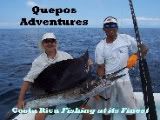
The beaches in Costa Rica are as diverse as the flora and fauna. The popular beaches like Playa Tamarindo, Jaco, and Manuel Antonio Beach can provide you with a hopping and exciting beach vacation.
At these an many other popular beaches in Costa Rica, you can enjoy the beautiful Pacific Caribbean Ocean while sitting in a chair beneath an umbrella, ordering a cold and fruity drink from the beach, and people watching. The popular beaches have nearby shops and restaurants, they are accessible by bus or by taxi. Sometimes, being at one of the popular tourist beach is just the right way to pass the day.
But for me, one of the beautiful things about Costa Rica is the large number of undeveloped beaches. There are countless little explored and less developed beaches along the Pacific coast from Playa Junquillal to Esterillos to Uvita, to the small beaches of the Osa Peninsula.
 Today we visited Playa Palo Seco and were literally the only people enjoying the sound of the roaring surf. This beach is one of our favorite beaches, mostly because it is almost always deserted. Even in the midst of high season you can walk for miles collecting sand dollars and sea glass (a new hobby of mine since reading the novel by Anita Shreve) without encountering another person. With the tide out there are countless rocks, shells, sand dollars and pieces of sea glass to find. If a brisk walk or run is more your style you have 9 miles of open beach to cover while enjoying sound of roaring surf and a vista of Manuel Antonio in the distance.
Today we visited Playa Palo Seco and were literally the only people enjoying the sound of the roaring surf. This beach is one of our favorite beaches, mostly because it is almost always deserted. Even in the midst of high season you can walk for miles collecting sand dollars and sea glass (a new hobby of mine since reading the novel by Anita Shreve) without encountering another person. With the tide out there are countless rocks, shells, sand dollars and pieces of sea glass to find. If a brisk walk or run is more your style you have 9 miles of open beach to cover while enjoying sound of roaring surf and a vista of Manuel Antonio in the distance.Although there is not much development along Isla Palo Seco, if you haven’t brought your own refreshment, you can find a cold drink and a nice lunch at the Timarai Bamboo Resort. I like to travel to Palo Seco early, enjoy the beach, then get a freshwater rinse off and cold drink at the resort. With lunch or a drinks at the restaurant you can enjoy the pool or lounge catch a little shade in a poolside lounge chair.
With over 800 miles of Coastline and two oceans from which to chose there is a beach for every traveler to Costa Rica. Whether you prefer black sand, white sand, pink sand, trendy, deserted, developed, primitive, pounding surf, or gentle lapping waves, your perfect beach awaits. Better yet, don't choose plan to visit several beaches during your visit.
When planning a trip to the beach it is always a good idea to check out the tide tables. Some beaches virtually disappear during high tide, but are expansive when the tide is out. If possible plan your visit near low tide and you will have hours to enjoy the beach.











